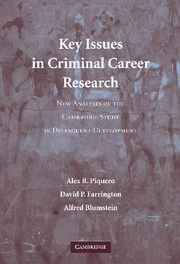 Key Issues in Criminal Career Research
Key Issues in Criminal Career Research Published online by Cambridge University Press: 30 July 2009
“Who are YOU?” said the Caterpillar. This was not an encouraging opening for a conversation. Alice replied, rather shyly, “I – I hardly know, sir, just at present – at least I know who I WAS when I got up this morning, but I think I must have been changed several times since then.” “What do you mean by that?” said the Caterpillar sternly. “Explain yourself!” “I can't explain MYSELF, I'm afraid, sir,” said Alice, “because I'm not myself, you see.” “I don't see,” said the Caterpillar. “I'm afraid I can't put it more clearly,” Alice replied very politely, “for I can't understand it myself to begin with; and being so many different sizes in a day is very confusing.”
(From Alice in Wonderland, Chapter 5, “Advice from a Caterpillar”).Criminologists have long been interested in the longitudinal patterning of criminal activity over the life-course, or how and why criminal behavior begins, continues, and ends. Prominent qualitative and quantitative studies have sought to describe individual initiation, continuation, and cessation of criminal offending. For example, Quetelet's (1831) Research on the Propensity for Crime at Different Ages was one of the first large-scale studies to provide a description of the aggregate relationship between age and crime. Shaw's (1928) The Jack-Roller told the captivating story of Stanley's delinquency in Chicago at the turn of the century.
To save this book to your Kindle, first ensure [email protected] is added to your Approved Personal Document E-mail List under your Personal Document Settings on the Manage Your Content and Devices page of your Amazon account. Then enter the ‘name’ part of your Kindle email address below. Find out more about saving to your Kindle.
Note you can select to save to either the @free.kindle.com or @kindle.com variations. ‘@free.kindle.com’ emails are free but can only be saved to your device when it is connected to wi-fi. ‘@kindle.com’ emails can be delivered even when you are not connected to wi-fi, but note that service fees apply.
Find out more about the Kindle Personal Document Service.
To save content items to your account, please confirm that you agree to abide by our usage policies. If this is the first time you use this feature, you will be asked to authorise Cambridge Core to connect with your account. Find out more about saving content to Dropbox.
To save content items to your account, please confirm that you agree to abide by our usage policies. If this is the first time you use this feature, you will be asked to authorise Cambridge Core to connect with your account. Find out more about saving content to Google Drive.